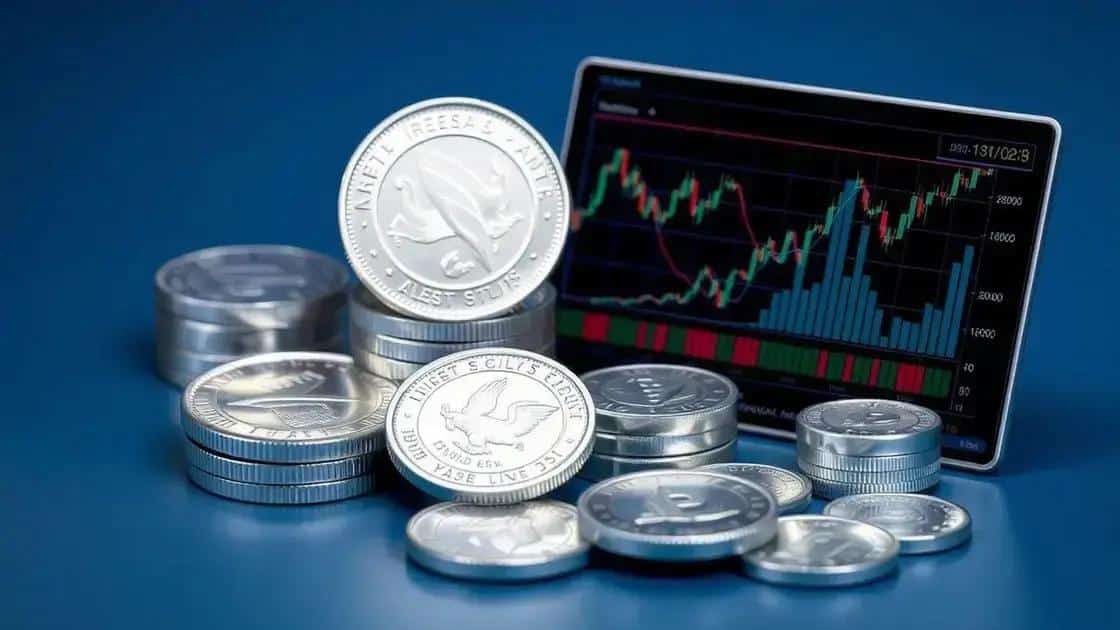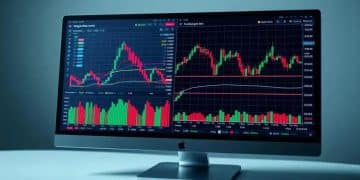Gold price trends vs silver: what’s the better investment?

Gold price trends vs silver show that while gold is a stable investment during economic uncertainty, silver’s volatility offers unique opportunities influenced by industrial demand and market conditions.
Gold price trends vs silver can be critical when making investment choices. Have you ever wondered which metal might bring you better returns or stability? Let’s explore how they stack up against each other.
Understanding gold price fluctuations
Understanding the gold price fluctuations is crucial for anyone looking to invest in this precious metal. The price of gold does not remain constant; it can rise and fall based on various factors affecting the economy and the market.
One major element influencing gold prices is inflation. When inflation rises, the purchasing power of currency declines. In such times, people often turn to gold as a safe haven. This increased demand can push prices higher. Furthermore, geopolitical tensions or economic instability can also impact gold prices, making it a reliable asset during uncertain times.
The Role of Supply and Demand
The balance between supply and demand plays a significant role in determining gold prices. If demand exceeds supply, prices will rise. Conversely, if supply surpasses demand, prices may decrease. Several factors can affect this balance:
- Mining production levels
- Central bank purchases or sales
- Jewelry demand during festive seasons
Additionally, the influence of global markets cannot be ignored. Economic growth in large economies such as China and the USA can lead to increased gold purchases as investors seek to hedge against future uncertainties. When these economies perform well, gold prices may see fluctuations based on varying investor behavior.
Currency Strength and Interest Rates
The strength of the US dollar also affects gold prices. Typically, when the dollar weakens, gold becomes cheaper for holders of other currencies, leading to increased demand. On the other hand, higher interest rates can deter investment in gold as yields on interest-bearing assets become more attractive.
In summary, observing the factors that contribute to gold price fluctuations can offer valuable insights into potential investment strategies. By staying informed, investors can make better decisions, whether they are looking to buy or sell this enticing commodity.
Analyzing silver investment potential

Analyzing silver investment potential requires an understanding of the unique characteristics of this precious metal. Silver is often regarded as an attractive option for both new and seasoned investors who look for diversification in their portfolios.
One of the key factors that make silver appealing is its lower price compared to gold. This affordability allows investors to acquire more physical silver, increasing their exposure to market movements. Furthermore, the industrial demand for silver contributes significantly to its value. It is commonly used in electronics, solar panels, and various medical applications.
Factors Influencing Silver Prices
Several economic factors can lead to fluctuations in silver prices:
- The strength of the US dollar
- Global economic conditions
- Supply and demand dynamics in various industries
In times of economic uncertainty or rising inflation, investors may turn to silver as a hedge, driving up its price. This behavior mirrors that of gold, making silver a valuable asset during turbulent periods.
Market Trends and Investment Strategies
Investors seeking to capitalize on silver investment potential should stay informed about market trends. Analyzing historical price data can offer insights into future movements, helping investors make informed decisions. Additionally, various investment options exist for those interested in silver:
- Physical silver bullion and coins
- Exchange-traded funds (ETFs) focused on silver
- Silver mining stocks
Utilizing a combination of these strategies allows investors to achieve a more balanced approach. By diversifying within the silver market, individuals can manage risk while taking advantage of its growth potential.
Comparing gold and silver market trends
Comparing gold and silver market trends is essential for investors looking to diversify their portfolios. Both metals serve as safe havens, but they react differently to market dynamics. Understanding these differences is key for making informed investment choices.
Gold is often seen as a long-term store of value. It tends to maintain its worth over time, especially during economic downturns. On the other hand, silver can be more volatile, offering both opportunities and risks for traders. This volatility can lead to significant price swings based on market sentiment and demand.
Historical Performance Analysis
Analyzing historical performance can provide insights into how each metal reacts during different economic conditions. For example, during periods of inflation, gold typically rises as investors seek stability. Silver, while also benefiting from inflationary pressures, can see sharper price increases due to its industrial demand.
- Gold tends to perform well in a crisis
- Silver’s prices are affected by industrial demand
- Both metals often rally during inflationary periods
In addition, seasonal trends play a role. For instance, silver often sees increased demand during holiday seasons, when jewelry sales rise. This seasonal flux can impact prices significantly compared to gold, which may not experience the same fluctuations.
Market Sentiment and Investor Behavior
Investor sentiment significantly influences the fluctuations of both metals. During times of uncertainty, gold can become a preferred option, leading to spikes in its price. In contrast, silver can attract a different type of investor, often those looking for more affordable entry points into precious metals.
Understanding these factors allows investors to navigate the market more effectively. By monitoring market trends, such as shifts in industrial usage or changes in consumer behavior, investors can better position themselves in either market. Overall, comparing gold and silver market trends enhances investment strategies and helps mitigate risks.
Factors influencing gold and silver prices

Factors influencing gold and silver prices are essential for understanding how these precious metals trade in the market. Various elements contribute to the shifts in pricing that investors must consider.
One major factor is the economic conditions surrounding global markets. When the economy is unstable, investors often flock to gold and silver as safe havens. This increased demand can raise prices significantly. Additionally, inflation plays a crucial role. As inflation rises, the purchasing power of currency decreases, prompting more people to invest in precious metals to preserve their wealth.
Supply and Demand Dynamics
The balance between supply and demand is fundamental in determining prices for both metals. If demand exceeds supply, prices will typically increase. Conversely, if there is a surplus of these metals in the market, prices may drop. Here are some specific factors that can affect supply and demand:
- Mining production levels
- Central bank buying or selling
- Consumer demand in jewelry and electronics
When mines produce less silver or gold, or when central banks decide to purchase these metals, prices can experience upward pressure. Changes in consumer demand, especially during holiday seasons, also impact prices significantly.
Currency Strength and Global Events
The strength of the US dollar is another critical factor. Generally, a weaker dollar makes gold and silver cheaper for foreign investors, leading to increased demand. Global events, such as geopolitical tensions or major policy changes, can create uncertainty, further driving investors toward precious metals.
Interest rates also play a role. When rates are low, the opportunity cost of holding gold and silver decreases, making them more appealing investments. Conversely, higher interest rates can lead investors to seek returns in other forms, which might lower demand for precious metals.
Understanding these factors influencing gold and silver prices helps investors make smarter decisions based on market conditions. By monitoring how these elements interact, one can better anticipate potential price movements in the precious metals market.
In conclusion, understanding the dynamics of gold and silver prices offers investors valuable insights into these precious metals. The factors influencing their value, such as supply and demand, economic conditions, and currency strength, are interlinked. By closely monitoring these elements, investors can make better-informed decisions, whether they are looking to buy or sell. Staying updated on market trends and global events also helps in navigating potential investments in gold and silver. Ultimately, each metal has its unique characteristics, and knowing how they work can enhance your investment strategy.
FAQ – Frequently Asked Questions About Gold and Silver Prices
What factors influence the prices of gold and silver?
Prices are influenced by supply and demand, economic conditions, currency strength, and global events.
Why is gold considered a safe haven investment?
Gold is seen as a stable asset during times of economic uncertainty, attracting investors looking to preserve value.
How does inflation affect gold and silver prices?
During inflation, the purchasing power of currency declines, leading investors to buy gold and silver to protect their wealth.
Can I diversify my investment with gold and silver?
Yes, including both metals in your portfolio can help balance risk and enhance potential returns.






